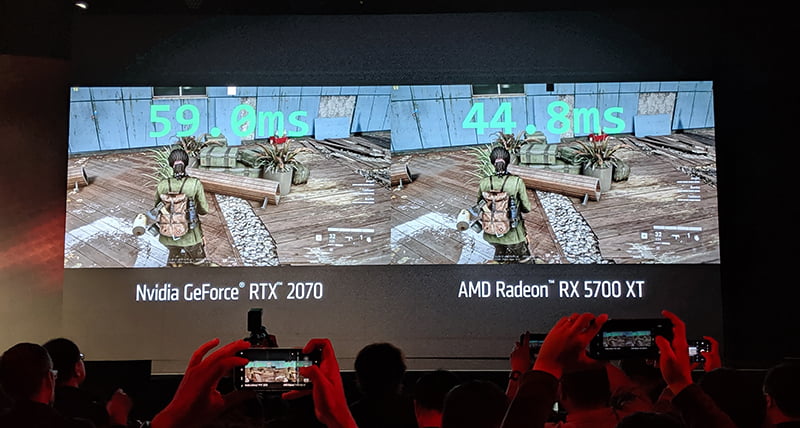Two big graphics cards are now coming with a bang. Today, we’re showing you if you should by an Nvidia GeForce RTX 2070 or AMD Radeon RX 7700 XT with the full comparison.
AMD introduced a new version of Adrenalin 2019 Edition software with the new Navi-based Radeon RX 5700 series graphics card. Version 19.7.1 brings some new features that improve the visual quality and performance of the game and reduce power consumption. It will be available for download on July 7th with the new Radeon RX 5700 XT and Radeon RX 5700.
AMD lists the three core pillars of its new Navi graphics card, the new RDNA game architecture, game fidelity and game dynamics.
The latter two are the focus of their Adrenalin software. Game fidelity focuses on the appearance of the game, including advanced anti-pull techniques and physical calculations, while gameplay involves all aspects of gameplay, such as how smooth and responsive. However, most of the features here are not limited to Navi, you can enjoy them on existing Radeon GPUs.
AMD Radeon RX 7700 XT Antilag Feature
One of the biggest features is called Radeon Anti-lag, which is a very simple name that fits perfectly with it. It should reduce click response time or reduce latency between the GPU and the display.

In general, having a higher frame per second will provide a lower latency, but Radeon Anti-lag simulates this effect without actually requiring the required performance. The idea behind this is to separate the frame rate from the input lag so that the latter is no longer dependent on the former. In the live demo, AMD showed a delay from about 56ms to 44.8ms, compared to 59ms for the GeForce RTX 2070.
Usually, your CPU will wait for your GPU to draw two frames, and then it will react to your clicks, but Radeon Anti-lag lets it selectively get rid of almost the entire frame, so you can get a faster response.
The most obvious target audiences include those who regularly participate in competitive eSports champions and other fast-paced action games. The company released a slide show of various games that benefited from this feature, including popular games like Apex Legends, Fortnite, Overwatch and Tom Clancy’s Rainbow Six Siege.

Some delay reductions can even translate into the benefits of the entire framework, although casual players may not notice the difference, but it’s not hard to see why professionals would want it. That is, you might want to wait for the commenter’s number to better understand the actual effect of the feature.
AMD’s FidelityFX
As part of driving the game to become more beautiful, AMD also launched a product called FidelityFX, an open source image quality toolkit that developers can use.

It uses Contrast Adaptive Sharpening (CAS) to draw detail in low contrast areas while minimizing artifacts. It is suitable for almost any form of edge anti-aliasing and can improve performance at low cost. This is AMD’s answer to NVIDIA’s DLSS and Radeon Image Sharpening, except that it is not specific to ray tracing scenarios.
In addition, FidelityFX supports optional upsampling for high resolution displays. According to AMD, it runs the fastest on Navi and Vega-based GPUs, using Rapid Packed Math, which uses precision switching to package two FP16 operations into a single FP32 operation. This will reduce the accuracy, but it will increase the speed, which is very important when you want to render more detail without too much performance degradation.

The company said that many developers have taken steps to integrate FidelityFX into future games, including Ubisoft, WB Games, and Gearbox Software. Compared to Radeon Image Sharpening (a simple switching style in Adrenalin software), FidelityFX also gives developers more control over the visuals in the game.
AMD Radeon Image Sharpening
Another feature designed to improve image quality is Radeon Image Sharpening, which helps focus and draw more detail with minimal impact on performance. It works similarly to FidelityFX, except that you can enable it directly from Adrenalin. The larger details also mean that you should feel that you are playing at a near native 4K resolution without being affected by such high resolution performance.

However, this feature is currently unique to the Radeon RX 5700 series. The strange thing is that it only works with DirectX 9, 10, 12 and Vulkan on Windows 10. I hope that FidelityFX can help fill in the gaps in this feature support.
It combines contrast adaptive sharpening with an optional GPU upgrade to enhance detail for clearer, clearer visuals.
In the slide below, you can see how the portion of the rock surface appears to have a greater depth to the applied texture, and the detail is improved with the image sharpened open, especially in the area below the left bush. .

According to AMD, you don’t have to wait for developers to continue using the game because it already supports thousands of games. The list currently includes many new and old movies, such as Civilization VI, World of Warcraft, Battlefield V, Tom Clancy’s 2nd Division, Metro Exodus, Tomb Raider Shadow and so on.
Power Saving
To solve the problem, Radeon Chill has once again become more powerful. Chill works by reducing GPU usage in less-intensive scenarios, which can help you save power. However, it now supports display-aware adjustments, which means you can set a frame rate cap to match the display’s refresh rate. This will work for fixed or variable refresh rate monitors, which AMD says can save up to 2.5 times more power than before.

Elsewhere, there are various quality of life improvements, such as the new automatic low-latency mode, which lets your GPU tell TV to automatically enter low-latency gaming mode.
With the feature called Set Snapshot, you can also create, save, and load custom settings and configurations more easily. Most importantly, Radeon WattMan is upgrading the UI with new power meter and summary readings of automatic overclocking changes.
The latest version of Adrenalin also allows you to stream games from your PC on a wider range of platforms than ever before. Radeon ReLive adds support for Apple TV and Android TV, as well as a one-click connection to the AMD Link mobile app, which allows you to stream games and videos from your PC to your phone or tablet.




